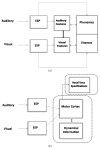Some behavioral and neurobiological constraints on theories of audiovisual speech integration: a review and suggestions for new directions
- PMID: 21968081
- PMCID: PMC3293210
- DOI: 10.1163/187847611X595864
Some behavioral and neurobiological constraints on theories of audiovisual speech integration: a review and suggestions for new directions
Abstract
Summerfield (1987) proposed several accounts of audiovisual speech perception, a field of research that has burgeoned in recent years. The proposed accounts included the integration of discrete phonetic features, vectors describing the values of independent acoustical and optical parameters, the filter function of the vocal tract, and articulatory dynamics of the vocal tract. The latter two accounts assume that the representations of audiovisual speech perception are based on abstract gestures, while the former two assume that the representations consist of symbolic or featural information obtained from visual and auditory modalities. Recent converging evidence from several different disciplines reveals that the general framework of Summerfield's feature-based theories should be expanded. An updated framework building upon the feature-based theories is presented. We propose a processing model arguing that auditory and visual brain circuits provide facilitatory information when the inputs are correctly timed, and that auditory and visual speech representations do not necessarily undergo translation into a common code during information processing. Future research on multisensory processing in speech perception should investigate the connections between auditory and visual brain regions, and utilize dynamic modeling tools to further understand the timing and information processing mechanisms involved in audiovisual speech integration.
Figures

Similar articles
-
Neural Mechanisms Underlying Cross-Modal Phonetic Encoding.J Neurosci. 2018 Feb 14;38(7):1835-1849. doi: 10.1523/JNEUROSCI.1566-17.2017. Epub 2017 Dec 20. J Neurosci. 2018. PMID: 29263241 Free PMC article.
-
How are visemes and graphemes integrated with speech sounds during spoken word recognition? ERP evidence for supra-additive responses during audiovisual compared to auditory speech processing.Brain Lang. 2022 Feb;225:105058. doi: 10.1016/j.bandl.2021.105058. Epub 2021 Dec 17. Brain Lang. 2022. PMID: 34929531
-
Neurophysiological Indices of Audiovisual Speech Processing Reveal a Hierarchy of Multisensory Integration Effects.J Neurosci. 2021 Jun 9;41(23):4991-5003. doi: 10.1523/JNEUROSCI.0906-20.2021. Epub 2021 Apr 6. J Neurosci. 2021. PMID: 33824190 Free PMC article.
-
Timing in audiovisual speech perception: A mini review and new psychophysical data.Atten Percept Psychophys. 2016 Feb;78(2):583-601. doi: 10.3758/s13414-015-1026-y. Atten Percept Psychophys. 2016. PMID: 26669309 Free PMC article. Review.
-
Prediction and constraint in audiovisual speech perception.Cortex. 2015 Jul;68:169-81. doi: 10.1016/j.cortex.2015.03.006. Epub 2015 Mar 20. Cortex. 2015. PMID: 25890390 Free PMC article. Review.
Cited by
-
Increased Connectivity among Sensory and Motor Regions during Visual and Audiovisual Speech Perception.J Neurosci. 2022 Jan 19;42(3):435-442. doi: 10.1523/JNEUROSCI.0114-21.2021. Epub 2021 Nov 23. J Neurosci. 2022. PMID: 34815317 Free PMC article.
-
Neural dynamics of audiovisual speech integration under variable listening conditions: an individual participant analysis.Front Psychol. 2013 Sep 10;4:615. doi: 10.3389/fpsyg.2013.00615. eCollection 2013. Front Psychol. 2013. PMID: 24058358 Free PMC article.
-
Sensory-Cognitive Interactions in Older Adults.Ear Hear. 2016 Jul-Aug;37 Suppl 1(Suppl 1):52S-61S. doi: 10.1097/AUD.0000000000000303. Ear Hear. 2016. PMID: 27355770 Free PMC article. Review.
-
Parallel linear dynamic models can mimic the McGurk effect in clinical populations.J Comput Neurosci. 2016 Oct;41(2):143-55. doi: 10.1007/s10827-016-0610-z. Epub 2016 Jun 7. J Comput Neurosci. 2016. PMID: 27272510
-
Enhanced audiovisual integration with aging in speech perception: a heightened McGurk effect in older adults.Front Psychol. 2014 Apr 14;5:323. doi: 10.3389/fpsyg.2014.00323. eCollection 2014. Front Psychol. 2014. PMID: 24782815 Free PMC article.
References
-
- Altieri N. Toward a Unified Theory of Audiovisual Integration in Speech Perception. Indiana University; Bloomington, IN, USA: 2010.
-
- Auer ET, Jr., Bernstein LE. Enhanced visual speech perception in individuals with early onset hearing impairment. J. Speech Hearing Lang. Res. 2007;50:1157–1165. - PubMed
-
- Bernstein LE. Phonetic perception by the speech perceiving brain. In: Pisoni DB, Remez RE, editors. The Handbook of Speech Perception. Blackwell Publishing; Malden, MA, USA: 2005. pp. 79–98.
-
- Bernstein LE, Auer ET, Moore JK, Ponton C, Don M, Singh M. Visual speech perception without primary auditory cortex activation. NeuroReport. 2002;13:311–315. - PubMed
Publication types
MeSH terms
Grants and funding
LinkOut - more resources
Full Text Sources
